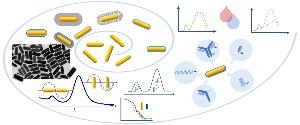Literature review on Gold Nanorods in BiosensorsGold Nanorods for LSPR Biosensing: Synthesis, Coating by Silica, and Bioanalytical Applications

Check our up-to-date overview of gold nanorods in LSPR biosensing. We start from synthesis and coating with a silica shell of controlled thickness and porosity, then, we discuss surface functionalization to attach various bioreceptors and finally, we review AuNR-based LSPR biosensors and their analytical performances.
link: https://doi.org/10.3390/bios10100146
Abstract: Nanoparticles made of coinage metals are well known to display unique optical properties stemming from the localized surface plasmon resonance (LSPR) phenomenon, allowing their use as transducers in various biosensing configurations. While most of the reports initially dealt with spherical gold nanoparticles owing to their ease of synthesis, the interest in gold nanorods (AuNR) as plasmonic biosensors is rising steadily. These anisotropic nanoparticles exhibit, on top of the LSPR band in the blue range common with spherical nanoparticles, a longitudinal LSPR band, in all respects superior, and in particular in terms of sensitivity to the surrounding media and LSPR-biosensing. However, AuNRs synthesis and their further functionalization are less straightforward and require thorough processing. In this paper, we intend to give an up-to-date overview of gold nanorods in LSPR biosensing, starting from a critical review of the recent findings on AuNR synthesis and the main challenges related to it. We further highlight the various strategies set up to coat AuNR with a silica shell of controlled thickness and porosity compatible with LSPR-biosensing. Then, we provide a survey of the methods employed to attach various bioreceptors to AuNR. Finally, the most representative examples of AuNR-based LSPR biosensors are reviewed with a focus put on their analytical performances
Also in the section
- Cover in ACS Sensors
- Cover Biosensors
- Article in Nanomaterials
- Anis arrival
- OrNano-YouTube
- Review in Biosensors & Bioelectronics
- Webinar SCT
- Insplorion - User Meeting
- JSE 2020 - French Electron Spectroscopy Workshop
- Sunny
- Mona arrival
- CNano-SFNano Joint Congress 2019 - Dijon
- Article in ACS Applied Materials & Interfaces
- Mederic Thesis Defense
- Article in Talanta
- Article in Nanoscale Advanced
- Cover for ACS Appl. Nano Mater.
- Nice gathering
- Alexis is leaving !
- Bruno and Raphael defense
- Souhir : Invited Lecture
- Article in biosensors
- Yacine Mazouzi, price
- BioSurf 2019
- Atul Parikh
- Cover for J Phys Chem C
- Mathieu Nicolas has joined us
- Bruno & Raphael
- Insplorion
- Ceremony for Master diploma
- Lu : PhD defense
- Fadoua's arrival
- Photoniques
- Daoming arrival
- Mathieu's paper in Journal of the Optical Society of America
- Somia Tomane - Thesis Defense
- Walid's arrival
- Valentin's arrival
- David Hu - Thesis defense
- Vincent Pellas - Thesis Defense
- Paper in ACS ANM
- Paper in ACS Sensors
- Yacine Mazouzi Thesis defense
- Issue-cover selected
- Review in Antibiotics
- IEEE Sensors Council France
- IEEE Sensors
- ACS Sensors
- Sara Martinez Concheso
- PhD defense Mathieu Nicolas
- PEP21 school

